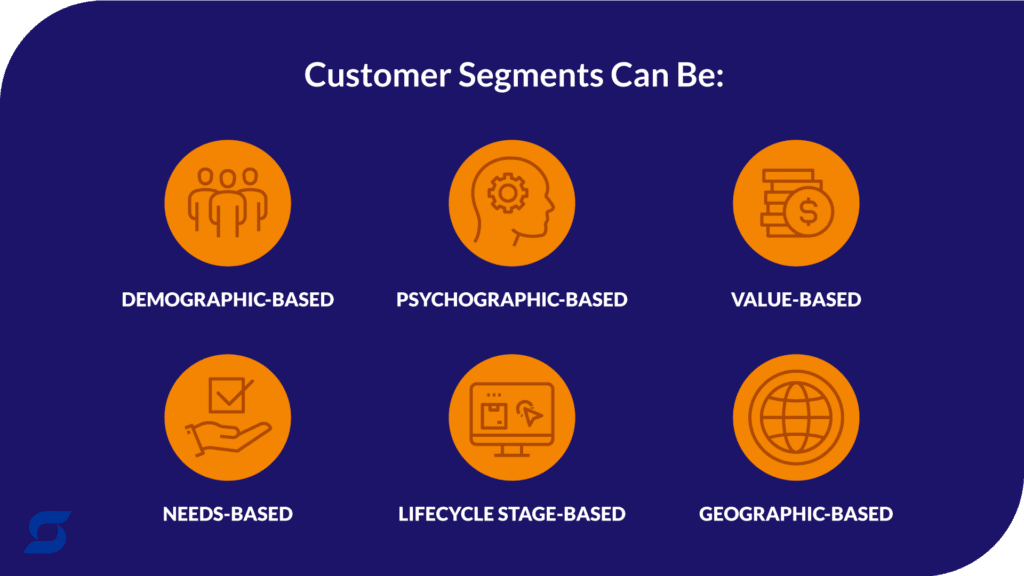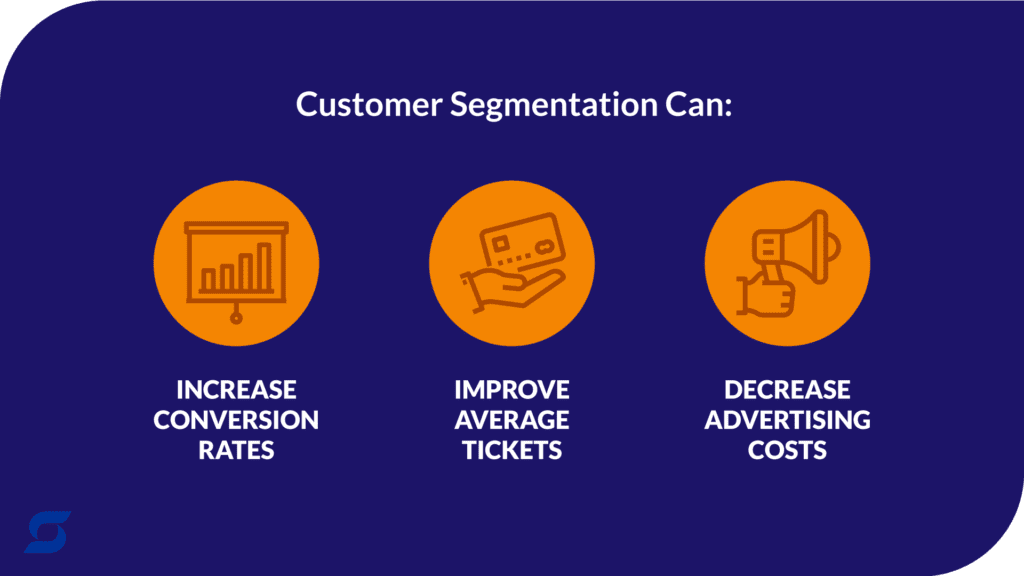Private equity firms are adept at optimizing EBITDA through operational enhancements when acquiring new platform businesses. However, it is common for PE leadership to overlook the opportunities to drive EBITDA growth through topline revenue improvement.
There are several tactics which can be used to improve topline revenue in an acquired company. One strategy that stands out for its ability to drive revenue without inflating advertising costs is Customer Segmentation Analysis. Or, said differently, the Art of Finding Your Most Profitable Customers.
In the next few sections, we’ll explore exactly how private equity firms can leverage customer segmentation. We’ll also look at how it fuels business growth when tactically leveraged in your go-to-market strategy.
What is Customer Segmentation?
Customer segmentation is the strategic process of grouping a company’s customer base into distinct groups. These groups are based on shared characteristics, behaviors, and preferences.
Segmentation allows private equity partners to learn more about their average customers. Most importantly though, it enables them to dial in their best, most profitable customers. This in turn allows their media partners to create targeted marketing campaigns, personalized messaging, and tailored strategies. These tactics will improve average tickets, conversion ratios (which ultimately boost profits), and add long-term customer value within each segment.
Unleashing the Power of Customer Segmentation
Follow the steps below to build topline revenue in your private equity acquisitions.
Clearly Define Criteria:
To kickstart the journey towards revenue improvement, it’s important to define precise customer segmentation criteria. These should include demographics (who your buyer is), psychographics (why they buy), income profile (who shops vs buys) and seasonal purchase patterns (identify diminishing returns).
The key is to ensure these criteria are actionable and measurable. They will lay the foundation for effectively leveraging your segmentation across your entire marketing plan.
Segmentation Analysis:
Leverage the wealth of customer data at your disposal to conduct segmentation analysis based on the defined criteria. For instance, you can group customers into distinct segments based on value.
Types of customer segments could include high-value, medium-value, and low-value customers. They could also include frequent purchasers, occasional purchasers, and high churn.
For more advanced usage, use statistical techniques or machine learning algorithms to uncover underlying patterns.
Assign Customer Value Metrics:
Develop metrics to assess the value of each customer segment accurately. Metrics such as customer lifetime value (CLV), average order value (AOV), and purchase frequency are key. These will help gauge how much value different segments are bringing to your business.
Map Segments Against Value Metrics:
Align each customer segment with the value metrics you’ve come up with. Look for segments that show the highest values based on your chosen metrics. Whether it’s a high purchase frequency or a higher average order value, decide what’s important to your business.
This allows you to prioritize segments with the greatest revenue potential. The more working media you expose these customers to, the more you will increase sales and boost your return on investment.
Consider Additional Factors:
While quantitative metrics are important, don’t ignore qualitative factors that add to the overall value of a customer segment. Keep in mind aspects like potential for future growth, brand loyalty, and referral potential when you evaluate segment value.
Validate Findings:
Check your segmentation findings against real-world data through rigorous testing and experimentation. A/B testing or controlled experiments can help prove the accuracy and reliability of your segmentation model. You’ll be able to move forward with confidence in your strategic decisions.
Develop Targeted Strategies:
Once you collect insights from your segmentation analysis, tailor your marketing to your segments. Craft targeted messaging, retention, and loyalty strategies made for the specific needs and preferences of each customer segment.
- Personalized messaging allows you to tailor your communication to the specific needs, preferences, and behaviors of each customer segment. It increases the relevance and likelihood a customer will relate to the marketing. That resonance boosts engagement, conversion rates, and overall effectiveness of your targeted marketing efforts.
- Exclusive offers motivate high-value customer segments by offering them unique benefits or discounts. These offers foster a sense of exclusivity and loyalty within those segments. They encourage repeat purchases and drive incremental revenue growth.
- Loyalty programs encourage repeat purchases through rewards, discounts, or incentives. These programs foster long-term customer relationships by rewarding customers for their continued engagement and purchases. They ultimately increase customer retention rates and lifetime value while encouraging brand loyalty and advocacy.
All these can effectively engage and retain valuable customers and grow brand loyalty, driving incremental revenue growth.
Expected Outcomes of Customer Segmentation
Increased Conversion Rates
Strategies tailored to high-value segments can lead to a significant boost in conversion rates, both online and offline with your sales force.
Improved Average Tickets
When you use a larger proportion of resources towards qualified individuals, expect to see increases in average transaction values.
Decreased Advertising Costs
As revenues increase due to efficient targeting, you can expect a drop in advertising costs relative to revenue.
Using Actionable Criteria
When a private equity firm plans to leverage customer segmentation for revenue growth, it’s important to recognize something. Singular factors may not lead to optimal results in isolation. While some criteria offer valuable insights, relying only on them can overlook key nuances. Consider the following examples:
Demographic Information
Demographics like age, gender, and income can offer insights into customer behavior. However, they’re most effective when combined with other factors for a thorough segmentation strategy.
Geographic Location
Geographic segmentation helps understand regional differences in customer preferences. Yet it might not always directly drive revenue strategies unless specific geographic opportunities come up. For example: the opening of new locations or targeting ads in certain regions.
Psychographic Traits
Psychographic segmentation includes values, lifestyles, and personalities. It gives helpful insights into consumer behavior. Translating into actionable steps may be challenging though, unless you have additional context or data around their influence on purchasing decisions.
Historical Purchase Data
While helpful for understanding past behavior, historical purchase data may not always accurately predict future buying patterns. When using historical purchase data, also consider market trends and changes in consumer preferences. Solely relying on past transactions limits the strength of segmentation.
The Importance of Revisiting Customer Segmentation
Private equity firms should revisit customer segmentation from time to time. As a general rule, it should typically happen every 1 to 2 years. Timing will depend on the unique needs of your business and the resources you have available.
This audit ensures that your plans align with evolving market trends, shifting customer preferences, and changes in business objectives. Regularly revisiting customer segmentation allows you to refine the criteria and metrics if needed. From there, you can adapt your strategies to build customer satisfaction and maximize topline revenue.
Conclusion
In the realm of private equity, maximizing returns quickly and efficiently is key. Using customer segmentation as a part of your go-to-market strategy can unlock untapped potential for revenue growth.
By strategically segmenting customers based on value metrics and tailoring strategies accordingly, you can expect:
- Increased Conversion Rates
- Improved Average Tickets
- Decreased Advertising Costs
Drive topline revenue without exponentially increasing advertising spend. It’s the best of both worlds, so take advantage. Embrace the power of customer segmentation analysis as an important step in your marketing strategy. Propel your portfolio companies towards sustainable growth and profitability.
Get in touch to learn more about how Scale Marketing uses insights to drive growth and business results for companies like yours.








